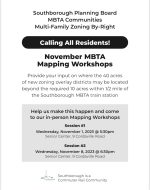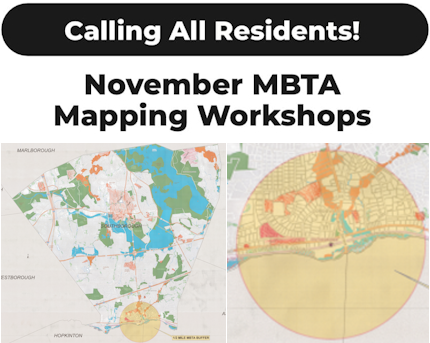Above: If you’re concerned about where the new zoning for dense housing should be sited throughout town, or in the area near the MBTA station, you may want to join the last mapping session with the Planning Board. (images cropped from flyer and map.)
This week, the Planning Board held its first MBTA Mapping Workshop. For those that missed it (or have new thoughts to share that they didn’t this week) there is another chance this Wednesday, November 8th.
A Planning Department member clarified that the input is for both the 10 acres of new zoning to be designated near the commuter rail station and the 40 acres beyond it.
(Initially, I had written based on the wording of the flyer that the focus wouldn’t include the 1/2 mile “dome” near the train station.)
The Planning Board is attempting to comply with the state’s MBTA Zoning regulations. For those not familiar, the intent is to find areas in town where multi-family housing up to 15 units per acre (on average) would be allowed “by right”.
 The second of two workshops will be held on November 8th at 6:30 pm in the Southborough Senior Center/Cordaville Hall (9 Cordaville Road).
The second of two workshops will be held on November 8th at 6:30 pm in the Southborough Senior Center/Cordaville Hall (9 Cordaville Road).
The November 1st event had a good turnout of around 50 people. The Senior Center can hold more. So if you are interested, this is your chance to weigh in.
But, for those who did attend, it’s not likely worth your time to return, unless you had new thoughts or changed your mind about what you previously told the board.
According to Planning’s Colleen Stansfield, the discussion will cover the same ground as it did this week. It’s mainly meant as a chance for people who couldn’t make it to the prior session. (Although you are entitled to attend again if you want to observe the feedback, especially since it won’t be streamed/broadcast.)
For those not familiar with the zoning initiative, you can read more context on what the board is doing and why in my prior post.



I feel that the largest issue regarding the MBTA zoning is the potential catastrophic impact to our town if the zoning is not carefully placed. The zoning requires a minimum of 50 acres supporting at least 15 housing units per acre, or a total of at least 750 housing units. Southborough currently hosts just over 3500 households, so we’re potentially looking at a 20-25% growth to the town’s residents. If this growth were to happen quickly, the effect on our schools and other public services would be devastating. The town needs time to adapt and evolve if such growth is to occur.
I’m told that the state was asked whether the new zoning could include restrictions that would allow the changes to be phased in over time, and the state responded, no.
So, it is incumbent on the planning process to identify locations that will inherently moderate the introduction of the higher density homes. Some people in the planning process noted that there exists a large parcel of “Industrial” land that could be developed into dense housing almost immediately. Such a selection must be avoided at all costs. Another suggestion was to locate the new zone on large areas of commercial or industrial land that appear to be valuable to the current users, such that the owners are unlikely to want to sell. This also carries a large risk, because if they DID sell, then we would immediately face the fast residential growth that we need to avoid.
If we have to implement a high-density residential zone, and we want to ensure that changes happen gradually, then the best choice would be to place the zone across an existing residential area, preferably one that has relatively smaller lot sizes. Home sales in such areas happen somewhat randomly and rarely simultaneously for contiguous lots, so it would be challenging for a developer to collect enough contiguous lots to make it profitable to replace valuable homes with higher density residences. Change to the neighborhoods, if it happens at all, will be at a slow pace that won’t exceed our town’s ability to adapt. We might see some existing homes converted to multi-family or the addition of Accessory Dwelling Units (ADUs), but such changes would not significantly affect the character of the neighborhoods nor create sudden population growth. Also, since any changes would be infrequent and sporadic, the new zoning should not have a significant impact on property values.
This was my thought, but I’m not a real estate expert, so I’m open to learning whether my assumptions about smaller lot sizes being a deterrent for rapid, higher-density development are valid.
It’s an issue that officials publicly discussed last spring. As I wrote about in a prior post covering April meeting between multiple committees and boards on how to address MBTA Zoning: